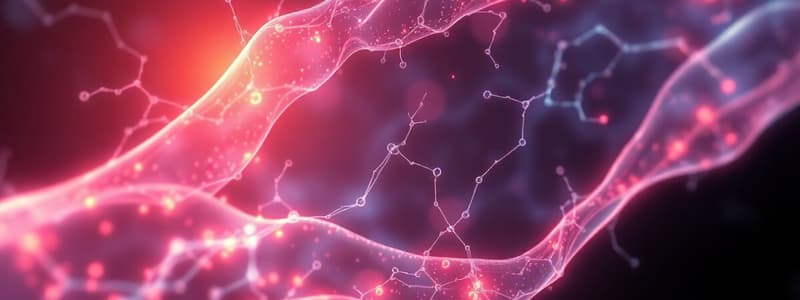Podcast
Questions and Answers
How does fascia respond to sustained physical stress?
How does fascia respond to sustained physical stress?
Fascia responds by remodeling itself, producing increased collagen fibers to deal with the specific stress.
What is the piezoelectric effect in relation to fascia?
What is the piezoelectric effect in relation to fascia?
The piezoelectric effect occurs when pressure or tension on fascia generates a slight electric charge, causing collagen molecules to orient relative to the electric field.
What role do myofibroblasts play in fascial response to physical stress?
What role do myofibroblasts play in fascial response to physical stress?
Myofibroblasts form in fascial sheets subjected to physical stress, increasing the strength of the fascia.
Explain the importance of a rehabilitation program after surgery for fascial healing.
Explain the importance of a rehabilitation program after surgery for fascial healing.
What happens if immobilization occurs at the site of a surgical incision during healing?
What happens if immobilization occurs at the site of a surgical incision during healing?
What role do myofibroblasts play in wound healing?
What role do myofibroblasts play in wound healing?
How does the contraction speed of myofibroblasts compare to that of skeletal muscle?
How does the contraction speed of myofibroblasts compare to that of skeletal muscle?
What stimuli can trigger the contraction of myofibroblasts?
What stimuli can trigger the contraction of myofibroblasts?
In what types of fascia have myofibroblasts been found in significant numbers even without injury?
In what types of fascia have myofibroblasts been found in significant numbers even without injury?
What effect do myofibroblasts have on musculoskeletal mechanics?
What effect do myofibroblasts have on musculoskeletal mechanics?
Flashcards are hidden until you start studying
Study Notes
Fascial Response to Physical Stress
- Fascia adapts to sustained physical stress by forming more collagen fibers, and orienting them according to the piezoelectric effect. The piezoelectric effect is the electrical charge produced when pressure or tension is applied to fascia.
- Myofibroblasts are cells that contribute to fascial adaptation to physical stress by contracting.
The Piezoelectric Effect
- The piezoelectric effect causes collagen fibers to align along the line of force, reinforcing and strengthening fascia in that direction.
- Fascia's adaptability is evident in wound healing, with collagen fibers aligning along lines of tension encountered during rehabilitation.
- The absence of rehabilitation can lead to disorganized collagen fiber formation, increasing the likelihood of excessive scarring.
Myofibroblast Formation
- Myofibroblasts are specialized cells with contractile ability due to the presence of alpha-smooth muscle actin filaments.
- The number of myofibroblasts varies but increases with physical stress on fascial tissue.
- Myofibroblasts are active in wound healing, pulling tissue edges together.
- Myofibroblast contraction is slow and sustained, stiffening tissues in response to long-term tensile forces.
- Myofibroblast contraction affects musculoskeletal mechanics, although weaker and slower than skeletal muscle.
- Myofibroblast contraction is not under direct neural control but is triggered by tensile forces and chemical compounds like nitric oxide, oxytocin, and growth factors.
Properties of Fascial Connective Tissue
- Creep is the gradual deformation of tissue under sustained force.
- Creep can be negative, as in ligament deformation due to hyperextension, or positive, as in therapeutic tissue remodeling.
- The rate of creep is higher with slower force application, highlighting the importance of gradual pressure in manual therapy.
- Thixotropy refers to the ability of fascia to change from a softer, more hydrated (liquid) sol state to a more rigid gel state.
- The sol state allows for increased blood and nutrient flow and movement.
- Hysteresis is the process of fluid loss and structural damage caused by friction and heat buildup during excessive tissue work, as in repetitive strain injury.
Myofascial Meridians and Tensegrity
- The myofascial unit refers to the interconnectedness of a muscle and its fascial tissues.
- Myofascial units work together in functional groups, sharing common joint actions.
- The myofascial-skeletal system includes fascial ligaments, joint capsules, bursae, tendon sheaths, articular and fibrous cartilage.
- Tensegrity structures are more resilient than compression structures because forces are distributed efficiently, diminishing their effect.
- Forces applied to the skeleton are transmitted through myofascial meridians, minimizing local impact.
- The body relies on both tensile and compressive forces for structural integrity.
- Bones of the skeleton contribute with compressive forces, but much of the skeletal stability arises from myofascial tensile forces connecting bones.
Introduction
- The myofascial system encompasses muscles and fascia, a network of connective tissue.
- Fascia is a continuous sheet of tissue that surrounds, protects, and supports all body structures, contributing to body shape.
- Fascia responds to mechanical loads through mechanoreceptors, including Golgi tendon organs, Pacini and Ruffini corpuscles, and interstitial mechanoreceptors.
- Fascia is dynamic, adapting to internal and external tensions.
- Fascia is a colloid, a constantly changing substance with varying resistance to pressure based on application velocity.
Elastic Properties and Force Transmission
- Fascia possesses elasticity, enabling it to withstand deformation and recover its shape.
- Fascia exhibits an elastic response initially, followed by creep with sustained loading.
- Creep involves water loss from the tissue and deformation.
- Fascial recovery occurs through elastic recoil and hysteresis, but the time required depends on water uptake and whether elastic potential was exceeded.
Studying That Suits You
Use AI to generate personalized quizzes and flashcards to suit your learning preferences.





